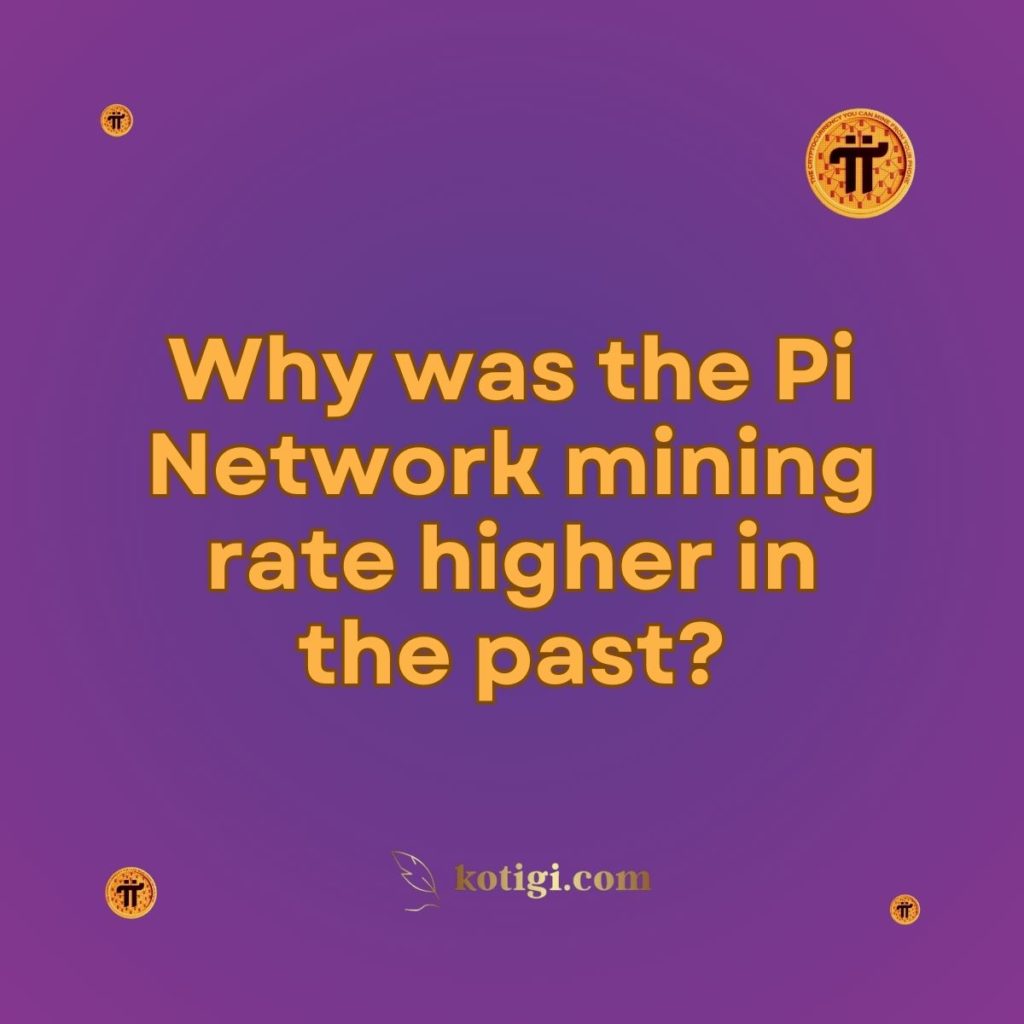
Why was the Pi Network mining rate higher in the past?
The Pi Network’s mining rate was higher in its early stages to incentivize new users to join the network. As more users joined and the total supply of Pi increased, the mining rate gradually decreased to maintain scarcity and value. This model follows Pi’s vision of becoming a widely distributed cryptocurrency while ensuring that early adopters are rewarded for their contributions.
Introdution
The Pi Network has been a unique cryptocurrency in many ways, and one of its most distinguishing features is the mobile mining process that allows everyday users to mine Pi coins from their smartphones. However, many users have noticed that the mining rate was significantly higher when the network first launched compared to what it is today.
This decline in the mining rate has been a deliberate part of the Pi Network’s design, aimed at incentivizing early adopters while ensuring a sustainable long-term supply of the currency. In this article, we will explore why the Pi mining rate was higher in the past, the factors that led to its decrease, and what this means for current and future users of the network.
Understanding Pi Network’s Mining Mechanism
What Is Pi Mining?
Unlike traditional cryptocurrencies like Bitcoin that rely on Proof of Work (PoW) mechanisms, Pi Network’s mining process is energy-efficient and designed to run on mobile devices. Users can mine Pi by opening the app daily and pressing the “mine” button, which validates their participation in the network. The mining process on Pi does not require high-powered computers or energy-consuming calculations, making it accessible to everyone with a smartphone.
How Does Pi’s Mining Rate Work?
The mining rate in Pi Network refers to the speed at which users can earn new Pi coins. Initially, when Pi Network launched, the mining rate was set higher to encourage users to join and mine Pi regularly. However, the mining rate decreases over time as the network grows, a strategy designed to limit the total supply of Pi and create scarcity.
The mining rate is influenced by several factors, including:
- User growth: As more people join Pi Network, the mining rate decreases to slow the creation of new Pi coins.
- Halving events: Similar to Bitcoin, Pi experiences halving events that reduce the mining rate by 50% at key milestones in the network’s development.
- Contribution to the network: Users can increase their individual mining rates by referring others to join Pi, verifying their identity (KYC), and participating in security circles.
Why Was the Mining Rate Higher in the Early Days?
Encouraging Early Adoption
One of the primary reasons Pi Network had a higher mining rate in the early stages was to incentivize early adopters. When Pi first launched, it was a new and experimental cryptocurrency with no real monetary value. To attract a large number of users to the platform, the network rewarded early users with a higher mining rate as a way to build momentum and spread the word about the project.
Early adopters of any cryptocurrency project typically take on more risk, as the project is unproven and the future value of the currency is uncertain. To reward these users for their support and trust in the project, Pi Network allowed them to mine Pi at a faster rate. This strategy was intended to build a large and engaged community during the network’s initial phase.
Network Growth and Supply Control
Another key reason for the higher mining rate in the past was network growth. At the time of Pi’s launch, the network had very few users, and the Pi team wanted to ensure rapid growth. By offering a high mining rate, they encouraged users to not only join the network but also refer others, contributing to Pi’s viral growth.
As the network expanded and more users began mining Pi, the team needed to control the supply of new Pi coins entering circulation. To avoid overinflation of the currency and maintain long-term value, the Pi Network gradually reduced the mining rate as the user base grew. This reduction ensures that the total supply of Pi remains finite and scarce, which is crucial for creating future value for the coin.
How Does the Pi Network Mining Rate Change Over Time?
Halving Events
A significant mechanism for controlling the mining rate is halving events. Pi Network has structured its mining rate to be cut in half when specific milestones in user growth are reached. This process is inspired by Bitcoin’s halving, which occurs every four years to limit the supply of new Bitcoins entering the market.
Pi Network’s halving events happen when the network reaches a certain number of users. For example:
- When Pi reached 1 million users, the mining rate was halved for all users.
- When Pi hit 10 million users, another halving event occurred, further reducing the rate at which new Pi coins could be mined.
These halving events ensure that as Pi becomes more popular, fewer new coins are introduced into circulation, maintaining scarcity and preventing inflation.
User Contribution and Rewards
While the overall mining rate decreases for everyone over time, individual users can still increase their personal mining rates by contributing to the network in various ways. The Pi Network encourages users to build security circles (trusted groups of friends and family) and refer new users to the platform. This helps maintain a strong and secure network, and in return, users are rewarded with a higher personal mining rate.
Additionally, users who complete the Know Your Customer (KYC) verification process are eligible for additional mining rewards, ensuring that only verified users can earn and use Pi when the network fully launches.
The Impact of a Lower Mining Rate
Limited Supply and Value Creation
As the mining rate decreases over time, the total supply of Pi coins becomes more limited. This scarcity is a critical component in the creation of value for Pi in the long term. By reducing the mining rate as more users join the network, Pi Network ensures that early adopters are rewarded with more Pi, while new users face a slower mining rate, creating supply scarcity.
In traditional financial markets, scarcity often leads to increased demand, which could drive up the value of Pi coins once they are tradable on exchanges. However, it’s important to note that Pi coins currently have no monetary value, as the network is still in its enclosed Mainnet phase. The long-term value of Pi will depend on factors like network adoption, utility, and the launch of the open Mainnet.
Long-Term Sustainability
The gradual reduction in Pi’s mining rate is essential for the long-term sustainability of the network. If the mining rate remained high indefinitely, there would be an oversupply of Pi coins, which could lead to inflation and devalue the currency. By lowering the mining rate, Pi Network ensures that the total supply remains controlled, helping to maintain value as the network matures.
This reduction also aligns with Pi’s vision of becoming a widely distributed cryptocurrency that is accessible to everyone, but also valuable due to its limited supply.
What Should Users Expect in the Future?
Future Halving Events
As Pi Network continues to grow, users can expect further halving events that will continue to lower the mining rate. Each halving will reduce the number of new Pi coins entering circulation, making it more challenging for users to mine significant amounts of Pi. However, these halving events are crucial for maintaining the value of Pi in the future.
It’s important for users to stay informed about upcoming halving events and adjust their mining strategies accordingly. Users can increase their personal mining rates by participating in security circles, completing KYC verification, and referring new users to the network.
Open Mainnet and Pi’s Value
The most anticipated milestone for Pi Network users is the launch of the open Mainnet, which will allow Pi to be traded on public exchanges and potentially gain real monetary value. Until then, users should continue mining and contributing to the network, as early adoption and participation could lead to greater rewards in the future.
Once the open Mainnet is launched, the total supply of Pi coins will be capped, and no new coins will be mined. This means that the current mining period is limited, and users should take advantage of the opportunity to mine while they still can.
Conclusion
The Pi Network mining rate was higher in the past to incentivize early adopters and promote rapid growth. As the network has expanded and more users have joined, the mining rate has gradually decreased to control the supply of new Pi coins and maintain long-term sustainability. Through halving events and user contributions, Pi Network ensures that its currency remains scarce, valuable, and accessible to all.
While the current mining rate is lower than it was in the early days, users can still maximize their mining potential by contributing to the network and completing KYC verification. As Pi Network moves closer to launching its open Mainnet, the controlled mining rate will play a critical role in creating future value for the cryptocurrency.
Key Takeaways:
- The Pi Network mining rate was higher in the past to encourage early adoption and rapid network growth.
- The mining rate decreases over time through halving events, ensuring the controlled supply of Pi coins.
- Early adopters were rewarded with faster mining rates, while current users face lower rates to maintain scarcity.
- Users can still increase their personal mining rates by contributing to the network through security circles, referrals, and KYC verification.
- Future halving events and the launch of the open Mainnet will determine Pi’s long-term value and supply.





